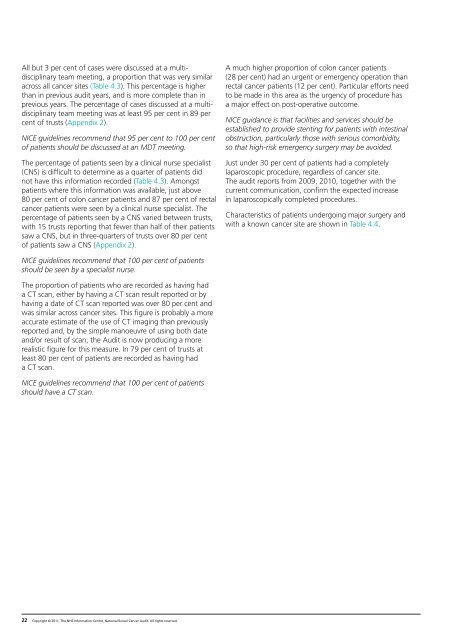National Bowel Cancer Audit Report 2011 - HQIP
National Bowel Cancer Audit Report 2011 - HQIP
National Bowel Cancer Audit Report 2011 - HQIP
Create successful ePaper yourself
Turn your PDF publications into a flip-book with our unique Google optimized e-Paper software.
All but 3 per cent of cases were discussed at a multidisciplinary<br />
team meeting, a proportion that was very similar<br />
across all cancer sites (Table 4.3). This percentage is higher<br />
than in previous audit years, and is more complete than in<br />
previous years. The percentage of cases discussed at a multidisciplinary<br />
team meeting was at least 95 per cent in 89 per<br />
cent of trusts (Appendix 2).<br />
NICE guidelines recommend that 95 per cent to 100 per cent<br />
of patients should be discussed at an MDT meeting.<br />
The percentage of patients seen by a clinical nurse specialist<br />
(CNS) is difficult to determine as a quarter of patients did<br />
not have this information recorded (Table 4.3). Amongst<br />
patients where this information was available, just above<br />
80 per cent of colon cancer patients and 87 per cent of rectal<br />
cancer patients were seen by a clinical nurse specialist. The<br />
percentage of patients seen by a CNS varied between trusts,<br />
with 15 trusts reporting that fewer than half of their patients<br />
saw a CNS, but in three-quarters of trusts over 80 per cent<br />
of patients saw a CNS (Appendix 2).<br />
A much higher proportion of colon cancer patients<br />
(28 per cent) had an urgent or emergency operation than<br />
rectal cancer patients (12 per cent). Particular efforts need<br />
to be made in this area as the urgency of procedure has<br />
a major effect on post-operative outcome.<br />
NICE guidance is that facilities and services should be<br />
established to provide stenting for patients with intestinal<br />
obstruction, particularly those with serious comorbidity,<br />
so that high-risk emergency surgery may be avoided.<br />
Just under 30 per cent of patients had a completely<br />
laparoscopic procedure, regardless of cancer site.<br />
The audit reports from 2009, 2010, together with the<br />
current communication, confirm the expected increase<br />
in laparoscopically completed procedures.<br />
Characteristics of patients undergoing major surgery and<br />
with a known cancer site are shown in Table 4.4.<br />
NICE guidelines recommend that 100 per cent of patients<br />
should be seen by a specialist nurse.<br />
The proportion of patients who are recorded as having had<br />
a CT scan, either by having a CT scan result reported or by<br />
having a date of CT scan reported was over 80 per cent and<br />
was similar across cancer sites. This figure is probably a more<br />
accurate estimate of the use of CT imaging than previously<br />
reported and, by the simple manoeuvre of using both date<br />
and/or result of scan, the <strong>Audit</strong> is now producing a more<br />
realistic figure for this measure. In 79 per cent of trusts at<br />
least 80 per cent of patients are recorded as having had<br />
a CT scan.<br />
NICE guidelines recommend that 100 per cent of patients<br />
should have a CT scan.<br />
22 Copyright © <strong>2011</strong>, The NHS Information Centre, <strong>National</strong> <strong>Bowel</strong> <strong>Cancer</strong> <strong>Audit</strong>. All rights reserved.

















